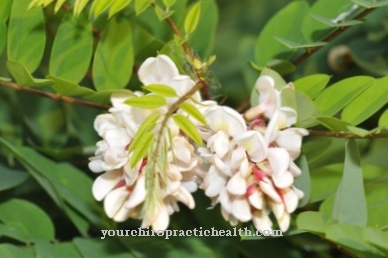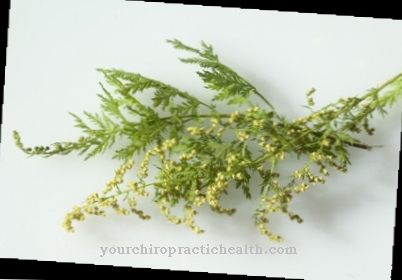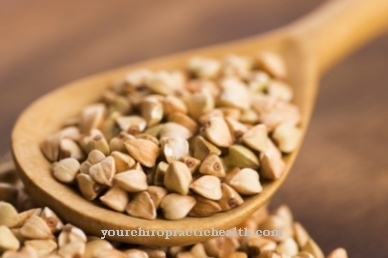Of the Dockis a popular wild and medicinal herb with a high vitamin C content, known as a salad spice and valued for its healing properties, especially for gastric and intestinal catarrhs. Finely dosed, it shines in teas, sauces and salads thanks to its sour, hot taste.
Occurrence & cultivation of dock

Of the Dock takes its name from the Middle High German word "amper", which translates as "shudder, sharp, bitter". The knotweed family is a member of the Rumex plant genus with around 130 to 200 different species worldwide.
It occurs mainly on wet meadows, swampy pastures, on farms, on roadsides or on rubble in all of Central Europe. Some species grow at altitudes of 1600 or even up to 2000 m. He prefers nutrient-rich locations, loamy-clay soils and waterlogging.
The medicinal herb has a perennial, persistent and herbaceous growth form. The dock grows in large, lanceolate and fleshy leaves that are arranged alternately. In contrast to the upper leaves, the basal leaves have entire margins, long stalked with mostly spear-shaped leaf bases. A distinguishing feature is the clear middle nerve of the leaves. Krauser Ampfer sprouts a stalk up to 1.50 m high with smaller leaves and green flowers in knotty pseudo-clusters.
Roman dock, on the other hand, is about 15 to 50 cm high. The root system extends vertically and particularly deep into the ground. The dock species can easily be confused with each other and with other knotweed plants. Depending on the species, the collection time varies from April to May and July to August or October. He is popular as big dock, Sorrel, Sour grass, Sour knotweed and Meadow Sorrel known.
Effect & application
In modern herbal medicine, the curly and blunt-leaved dock and sorrel are known as medicinal products. The leaves and seeds, the fresh sap and the dried rhizomes are used. The plant components should be selected depending on the type of knotweed plant. The root of the frizzy amper (Rumex crispus) has a laxative, blood-purifying, bile-stimulating and detoxifying effect.
It is particularly suitable for skin problems such as acne and eczema or against fungal infections and arthritic complaints. The roots are dug up, cleaned and chopped up in autumn. They should be stored in a shady place and below 40 ° C. The leaves are higher in oxalate and contain more oxalic acid. Treatment is not advisable for gout and kidney stones or for pregnant and breastfeeding people.
Poisoning leads to vomiting, diarrhea and difficulty swallowing in humans and animals. In homeopathy, mainly medicines for respiratory infections and skin rashes are made from components of the frizzy ampoule. The sorrel (Rumex acetosa) and its leaves, on the other hand, are said to have a diuretic, hematopoietic, cleansing, anti-inflammatory and expectorant effect. They are used to treat indigestion, skin diseases, menstrual cramps and anemia.To do this, the young leaves are cut off just before they bloom above the ground, fresh or dried, and hot water is poured over them and left for ten minutes. The tea can be drunk as well as used externally. Envelopes made from crushed leaves are another possible application. Tea made from sorrel seeds is considered a remedy for worms. However, taking larger amounts (> 15g) is definitely not advisable in order to avoid poisoning.
In connection with other medicinal plants such as elderberry and cowslip, sorrel herb has been shown to be beneficial against inflammation of the airways and sinus infections. The leaves of the blunt-leaved vampire (Rumex obtusifolius) or pilot root taste spicy and go well in the kitchen. They are said to have a laxative, astringent, tonic, blood-cleansing and blood-building effect, similar to sorrel. The root has a lower oxalate content and is used as a laxative. The tannin-rich seeds of sorrel are effective against diarrhea.Importance for health, treatment & prevention
Dock generally contains vitamin C, oxalic acid, potassium dioxalate, iron, flavone glycosides, tannins, tannic acid and hyperosides. It is also rich in fiber, vitamins A and B6, magnesium, calcium and potassium, and proteins. The combination of these ingredients makes the dock a universally applicable agent. Red blood cells are formed due to a high iron content.
The general oxygen content in the body increases, organs are better supplied and the high potassium content also ensures a relieved cardiovascular system. The high vitamin C content, similar to that of a lemon, stimulates the immune system. The formation of white blood cells is stimulated, which means that pathogens are better warded off. Spring fatigue and even scurvy are thus counteracted. The dock is generally thought to have a refreshing and energizing effect.
The plant, known in agriculture as a weed, and its leaves and roots also have a beneficial effect on digestion. Flatulence, constipation and diarrhea can be noticeably reduced by a high fiber content. The root of the dock is a natural laxative. In addition, the dietary fiber ensures a lower cholesterol level and consequently a healthy heart. Dock definitely contains a lot of fiber, but low in calories and fat.
Already known in antiquity and in the Middle Ages for its cleansing and astringent properties, dock is also used in modern herbal medicine against skin impurities such as pimples or wounds and insect bites. Whole leaves or compresses with infusions are placed directly on the affected areas.
The pharmaceutical industry and veterinary medicine use ingredients of the amper as components of many products in connection with other medicinal plants. In view of a moderately strong allergic potency, dock should be avoided by allergy sufferers.
























.jpg)



